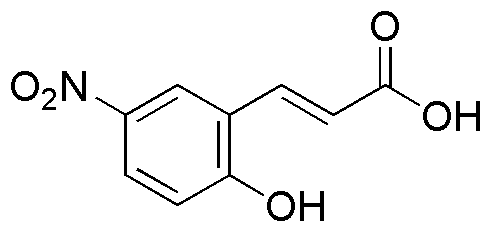2-Hydroxy-5-nitrocinnamic acid is widely utilized in research focused on:
- Pharmaceutical Development: This compound serves as an intermediate in the synthesis of various pharmaceutical agents, particularly those targeting inflammatory and cancerous conditions.
- Analytical Chemistry: It is used as a reagent in analytical methods, such as UV-Vis spectroscopy, to detect and quantify other compounds due to its distinct absorbance properties.
- Material Science: The compound is explored in the development of advanced materials, including polymers and coatings, that require specific light-absorbing characteristics.
- Biological Research: Researchers utilize it in studies related to enzyme inhibition and cellular signaling pathways, helping to elucidate mechanisms of action in various biological systems.
- Environmental Monitoring: It can be applied in the detection of pollutants, as its chemical structure allows for interactions with certain environmental contaminants, facilitating their identification.
General Information
Properties
Safety and Regulations
Applications
2-Hydroxy-5-nitrocinnamic acid is widely utilized in research focused on:
- Pharmaceutical Development: This compound serves as an intermediate in the synthesis of various pharmaceutical agents, particularly those targeting inflammatory and cancerous conditions.
- Analytical Chemistry: It is used as a reagent in analytical methods, such as UV-Vis spectroscopy, to detect and quantify other compounds due to its distinct absorbance properties.
- Material Science: The compound is explored in the development of advanced materials, including polymers and coatings, that require specific light-absorbing characteristics.
- Biological Research: Researchers utilize it in studies related to enzyme inhibition and cellular signaling pathways, helping to elucidate mechanisms of action in various biological systems.
- Environmental Monitoring: It can be applied in the detection of pollutants, as its chemical structure allows for interactions with certain environmental contaminants, facilitating their identification.
Documents
Safety Data Sheets (SDS)
The SDS provides comprehensive safety information on handling, storage, and disposal of the product.
Product Specification (PS)
The PS provides a comprehensive breakdown of the product’s properties, including chemical composition, physical state, purity, and storage requirements. It also details acceptable quality ranges and the product's intended applications.
Certificates of Analysis (COA)
Search for Certificates of Analysis (COA) by entering the products Lot Number. Lot and Batch Numbers can be found on a product’s label following the words ‘Lot’ or ‘Batch’.
*Catalog Number
*Lot Number
Certificates Of Origin (COO)
This COO confirms the country where the product was manufactured, and also details the materials and components used in it and whether it is derived from natural, synthetic, or other specific sources. This certificate may be required for customs, trade, and regulatory compliance.
*Catalog Number
*Lot Number
Safety Data Sheets (SDS)
The SDS provides comprehensive safety information on handling, storage, and disposal of the product.
DownloadProduct Specification (PS)
The PS provides a comprehensive breakdown of the product’s properties, including chemical composition, physical state, purity, and storage requirements. It also details acceptable quality ranges and the product's intended applications.
DownloadCertificates of Analysis (COA)
Search for Certificates of Analysis (COA) by entering the products Lot Number. Lot and Batch Numbers can be found on a product’s label following the words ‘Lot’ or ‘Batch’.
*Catalog Number
*Lot Number
Certificates Of Origin (COO)
This COO confirms the country where the product was manufactured, and also details the materials and components used in it and whether it is derived from natural, synthetic, or other specific sources. This certificate may be required for customs, trade, and regulatory compliance.


